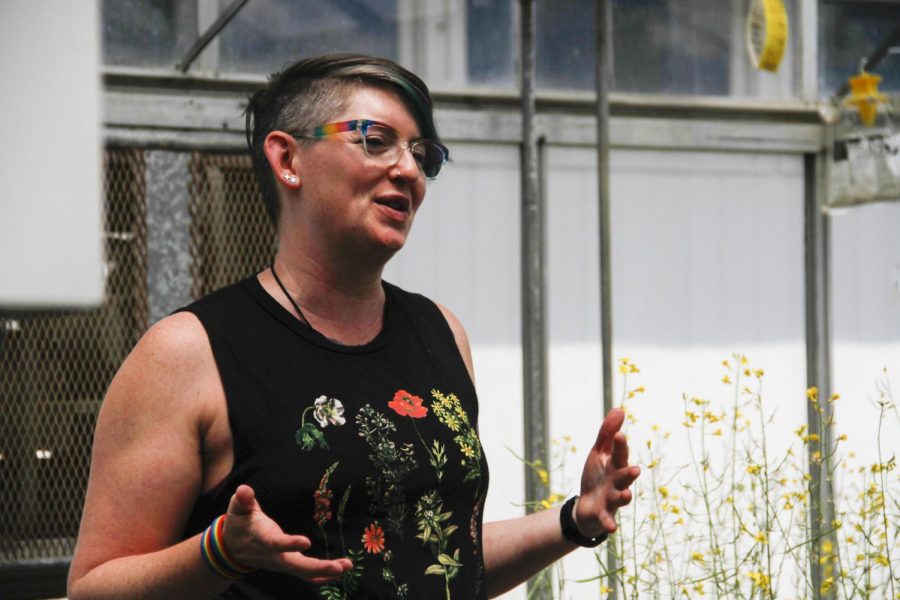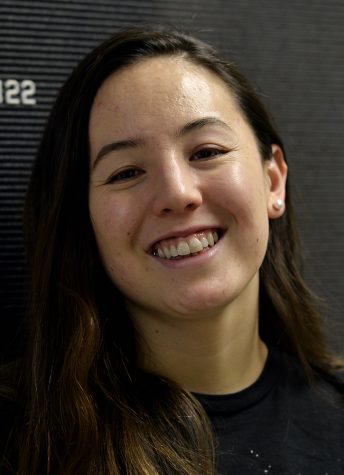‘Tomboy’ to Rumble Bee: Story of Growth
Rachel Olsson knew who they were, but didn’t always share that with the rest of the world. This is their story.
JESSICA HARJA | THE DAILY EVERGREEN
Rachel Olsson, a doctoral candidate at Washington State University, describes what they’ve experienced being out on the Palouse at the Entymology Greenhouse Tuesday afternoon.
June 19, 2019
Rachel Olsson was considered a “tomboy” as a child. They hated wearing dresses, liked sports and playing outside in the dirt. Now 32, Olsson remembers quickly learning to toe the line between a rough-and-tumble tomboy persona, and a more “girly” one.
Olsson, who prefers they/them pronouns but also uses she/her pronouns, is genderfluid, meaning a person who does not identify with a single fixed gender.
From a young age, Olsson noticed how people reacted to children who were like them.
“You would hear the parents whisper things like, ‘Hmm, she’s gonna grow up to be a lesbian,’ ” Olsson said. “Like, I don’t know, she might be a lesbian. She’s five.”
Olsson said they were aware of being queer — a term once used as a slur, and since reclaimed by the LGBTQ+ community — for as long as they can remember. Seeing how adults judged other children had a big impact on how they thought and acted, Olsson said.
As a doctoral candidate studying entomology at WSU, Olsson spreads their time across a variety of interests. Many hours are spent in their lab, where they study bee preferences for different varieties of canola plants, the main food source for bees in the region.
Olsson’s favorites are bumble bees, because “bumble bees are so soft and fluffy and cute,” they said. When Olsson joined roller derby in 2015 with the Palouse River Rollers, their favorite bees also served as inspiration for their derby name, “Rumble Bee.”
Now a coach for the Rolling Hills Derby Dames, finding a community that felt safe within roller derby was a big part of why Olsson came out two years ago, they said.
The sport is very queer-accepting in general, they said, and it was through meeting other queer people on the team that they felt safe, supported and comfortable enough to come out more visibly.
Being part of the queer community gave them a connection to people who understood some of what they went through.
“Everywhere you go, you have family,” Olsson said. “There’s a shared experience among queer people that the rest of the world doesn’t have.”
Before coming out, Olsson said they felt the whole world saw them as a cisgender, straight women. They had previously been in a relationship with a cisgender man, which only added to incorrect assumptions about their identity.
Looking at Olsson now, it would be harder to make the same mistake. A rainbow bracelet wraps one wrist, and rainbow-rimmed glasses sit on a nose beneath teal-tinted bangs.
“A lot of people will look at me and say, ‘oh, definitely lesbian,’ ” they said.
The way Olsson chooses to present themself feels more comfortable because others know who they are, and where they stand, Olsson said. They also use how they dress “as a signal” for other queer people around them.
“They know I’m someone safe, that they can talk to, that they can come to if they need anything,” Olsson said. “And I’ve had several people tell me that me that just my visible presence let them know that I was a safe person.”
But even though Olsson is proudly open about their identity, they still avoid some places they won’t be welcome. The community is “pretty solid,” but there are always a few hateful people.
“I’m heavily advertising my queerness all over my body,” they said. “But you won’t see a rainbow flag on my car because I don’t want my car to get keyed, and I know people who that has happened to in this town.”
Olsson has experienced homophobia and transphobia most of their life, they said. They don’t identify as transgender, but some parts of being genderfluid are similar. Like many transgender people, Olsson said they experienced dysphoria and anxiety, especially as a teenager and young adult.
The dysphoria was never enough to want to change their body, Olsson said, but made certain clothing items or makeup felt more or less comfortable depending on the day, and sometimes what felt right fluctuated in the middle of the day.
Olsson also said they wish their younger self to knew about The Trevor Project, where they now volunteer. The organization provides crisis intervention and suicide prevention services to LGBTQ+ youth.
If they had known about that resource as a teenager, Olsson said they think they would have been better able to understand their anxiety and random panic attacks.
“I didn’t have language for how I identify until recently. I didn’t understand why the outfit I wore yesterday feels like it’s suffocating me today,” they said. “I think I would have just been able to recognize that and take better care of myself if I had known what dysphoria was, what gender fluidity was, that it was a thing that anyone else experienced.”
Dealing with the anxiety brought on by their dysphoria made them more empathic, they said.
“That’s opened me up a lot to try to understand when I have a negative interaction with a person, recognizing a little bit better than that probably has nothing to do with me, and they’re probably dealing with something I can’t see,” Olsson said. “Maybe they’re dealing with something I’ll never know about. But it’s given me a lot more grace in my ability to move through the world.”
Olsson said even though they would have liked to know about the resources available to them when they were younger, they don’t have regrets because their experience is what made them the person they are today.
“I love the person that I am right now,” Olsson said. “I’m really happy in my life.”
One of Olsson’s biggest hopes, they said, is that that future political leaders in the U.S. will not “stand on a platform of hate,” Olsson said.
“[That] makes it seem OK to be violent and hateful and make people feel unsafe, and we do,” Olsson said. “I don’t want my people to feel unsafe.”
Another, they said, is that more young queer people will be able to find help through services like The Trevor Project. Olsson said they wish is that their younger self could have seen where they are today.
“I know younger me would think that current me is awesome,” they said. “Twenty-five-year-old me would think that 32-year-old me is the best.”










